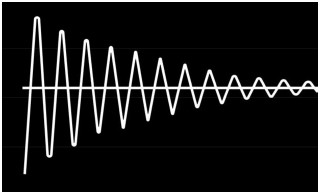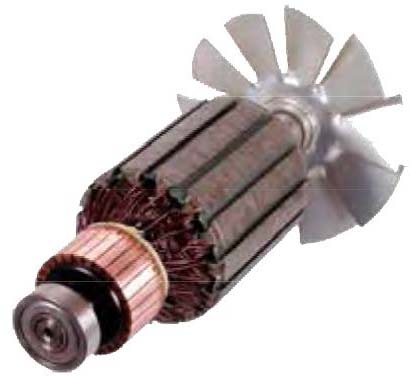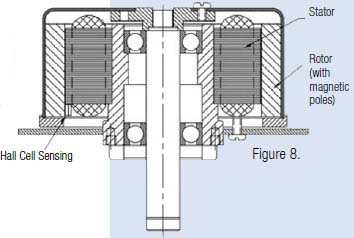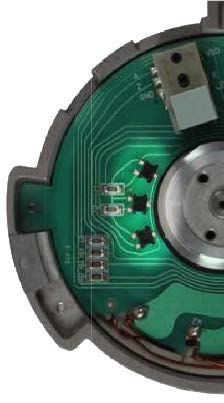In 1938, production began of a two phase synchronous induction motor which, at 60 Hz, ran at 75 RPM. The low speed resulted from there being a different number of rotor-to-stator poles or teeth which made the motor a good bi-directional control motor. This motor was used for running power driven auto-transformers used to dim lights in auditoriums and similar applications. Production on this motor ceased in the mid-1950’s because sales were not high enough to support production.
Engineers redesigned the motor to run at 72 RPM on 60 Hz and began to consider using a four step DC voltage sequence to have the motor move in increments of 1.8° per step or 200 steps per revolution. Micro-switches, magnetic reed switches and relays were used to demonstrate the basic operation at engineering conferences and seminars. In the early 1960’s transistors made operating the stepping motor practical and applications quickly developed. The hybrid stepping motor came alive.
 Principle of the Stepping Motor Principle of the Stepping Motor
If you create two magnetic fields of opposite polarities, they will attract each other, creating motion. If one of the magnetic fields is fixed on a shaft, you have rotary motion of some angle. Now to continue this rotary motion, you have to create a new magnetic field at a different position.
Figure 1 illustrates a typical step sequence for a two phase motor. In Step 1 phase A of a two phase stator is energized. This magnetically locks the rotor in the position shown, since unlike poles attract. In step 2, phase A is turned off and phase B is turned on. The rotor rotates 90° clockwise. In Step 3, phase B is turned off and phase A is turned on but with the polarity reversed from Step 1. This causes another 90° rotation. In Step 4, phase A is turned off and phase B is turned on, with polarity reversed from Step 2. Repeating this sequence causes the rotor to rotate clockwise in 90° steps. See Figure 2 for an electrical representation of the current flow in the two phases.
|
| Figure 2. |
 |
There is an electronic drive that sends the electrical pulses to the two phases at the appropriate time to create rotation. In this example, the rotation is 90° per pulse or step. In practice, the motors have more poles to create smaller step angles such as 15°, 7.5° or 1.8° per step. The term stepping motor traditionally refers to a motor that runs from pulses from an electron drive. By sending the motor a specific number of pulses, you would know the rotor position at any time. The movement created by each pulse is precise and repeatable, which is why stepper motors are so effective for positioning applications. However, all motors are really “stepping motors”. The only difference is the size of the step angle and how the switching of the pulses is created. Many AC motors can be run as stepping motors. The two phase alternating current 90 electrical degrees apart, creates a four step sequence just like the electronic drive except that it is a sine wave instead of a square wave. See Figure 3 below.
|
Figure 1.
 |
|
| Figure 3. |
 |
The limitation is that you are limited to only one speed, the 60 hertz of the incoming power. In this case, since the motor runs synchronously with the incoming frequency, it is now called a
synchronous motor – not a stepping motor. However, it is the same motor. Nothing has changed. The motor can also be made to run on a single phase AC current. A phase shifting circuit is usedto split the single phase into two phases.
 Variable Reluctance Motors Variable Reluctance Motors
A variable reluctance motor is a stepping motor that does not use a permanent magnet. A step is achieved by the principle that the rotor will rotate to minimize the reluctance path of a magnetic circuit. See Figure 4.
In the first step, pole 1 is magnetized north and pole 4 is magnetized south. In step 2, poles 2 and 5 are energized and poles 1 and 4 are turned off. The rotor rotates 60°. In step 3, poles 3 and 6 are energized and so on.
One of the disadvantages of a stepping motor is the ringing of the rotor when you take a single step. See Figure 5. The rotor does not stop instantly but oscillates about its final position for several milliseconds. If a second step is introduced while the rotor is moving in a negative direction, you have a conflict and loss of torque. In extreme cases, you can cause a resonance and the rotor will vibrate or stop.
| Figure 5. |
 |
|
Figure 4.  |
|
|
There are ways to dampen this oscillation but this increases the price. In a brush type or brushless motor, the switching is done at exactly the right time and this problem is minimized.
Brush type DC motors have several coils wound on a rotor or armature. These coils are connected to a commutator. The commutator consists of copper segments. See Figure 6. In this example shown, there are twelve coils so one step is or 30°. The switching is done mechanically instead of electronically by means of a commutator with 24 copper segments. The coils are connected to the copper segments. Two brushes, 180° apart connect to the appropriate coil which rotates the rotor
30°. See Figure 7.
|
| Figure 6. |
 |
Another version of this motor replaces the commutator and brushes with hall cells and a magnetic ring magnetized with many poles. See Figure 8. The hall cell is a magnetic switch which switches on in the presence of a south magnetic field. This energizes the proper coil to take the next step. This is called a brushless DC motor. A photo of a brushless DC motors is shown in Figure 9.
 Induction and Squirrel Cage Motors Induction and Squirrel Cage Motors
Induction and Squirrel Cage Motors have but a single turn electrical conductor in the rotor. They generally use copper bars or cast aluminum. The electric current is induced into the rotor from the stator field. These are AC motors and stepping is derived from the line frequency. There are many other specialized motors. However, the end result is still the same; to obtain rotary motion, you have to create a rotating magnetic field.
Every once in a while you hear that this motor is better than another motor. There is no such thing as a best motor. If this were true, there would only be one motor on the market. When you have an application, you have to determine which is the best motor for that application. You would have to consider such things as cost, dependability, life and many other factors.
In summary, there are four ways to obtain steps for motors; electronic commutation, mechanical, magnetic and electrical. Hybrid, permanent magnet and variable reluctance stepping motors receive their steps from an electronic drive. The brush type DC motor receives its steps by a mechanical commutator and brushes. This assembly converts direct current into steps. The brushless DC motor uses magnetic hall cells and magnets to convert direct current into steps. AC motors such as the induction motor, squirrel cage motor, hysteresis synchronous motor and many other motors use the line frequency of 60 hertz for their steps. Each alternation of the sine wave is a step. |
Figure 7.

Figure 8.

Figure 9.

|
Click here to download PDF version.